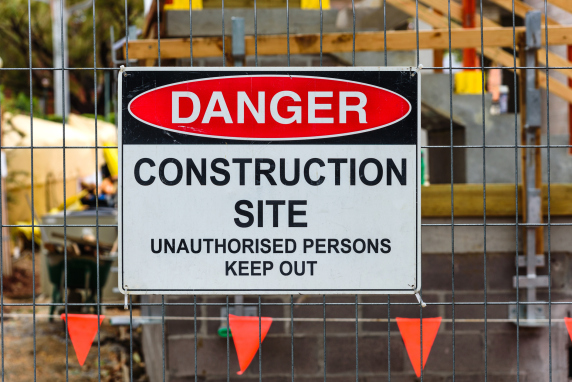How to Stay Safe In and Around a Construction Zone as a Pedestrian or Motorist

If, like many North Americans, you are an experienced motor vehicle operator or enjoy taking a stroll at twilight, then you are probably quite familiar with signs like the one pictured above. It is commonplace, as motorists and pedestrians, to encounter construction projects on our journeys—from routine maintenance to ongoing 400-series highway or interstate expansions.
While navigating these highways and byways can sometimes be frustrating or tedious, ongoing infrastructural improvements are the sign of a healthy state, one which is committed to the safety and efficiency of its populace, as seen, for example, in the $1 trillion infrastructure bill which was recently passed by U.S. Congress.
At home, The Government of Ontario recently pledged approximately $2.6 billion to build, expand, and repair Ontario’s highways and bridges, create jobs, and spur economic growth in the province. These investments, outlined in the 2021-22 budget, demonstrate a commitment to building a better and brighter future for families, workers, and businesses in Ontario.
As we begin to mentally prepare ourselves for these infrastructural revitalization projects in the coming years, it is important to remember the safety hazards that these spaces pose, no matter what your particular means of transportation. Here are some tips for navigating dangerous construction zones as a motorist or pedestrian:
Speed Hazards
Did you know that speeding is the number one cause of injury and death in highway construction work zones?
When navigating construction zones in an automobile or other motorized vehicle, whether you are an employee or civilian driver, it is imperative to pay attention to and obey the posted speed limit. Failure to do so can not only result in hefty fines and increase your Ontario car insurance, but can also put yourself and others at risk of injury or death.
There is no standard construction zone speed limit in Ontario. As a general rule, construction zone speed limits will be between 50km/h and 70km/h on highways and considerably less on secondary or regional roads. This is why it is so important to pay attention to signs notifying you of changes to the posted speed limits when entering construction zones.
When navigating these zones, keep your eyes on the road and safe distance between yourself and the vehicle in front of you, and be prepared to stop. Even if no workers are present, it is essential that you continue to follow these rules to protect yourself and others. Remember—drivers caught speeding in a construction zone can be fined up to $500 and lose 3 or more demerit points.
Struck-by Hazards
“Struck-by” is a term used to describe injuries from falling objects (i.e., tools, materials, equipment, or vehicles) in Ontario. Struck-by accidents are the third-highest cause of work zone deaths in the province, accounting for 13% of all deaths, behind motor vehicle accidents (36%) and falls (18%).
When moving through construction work zones as a pedestrian, it is important to be aware of your surroundings, to obey traffic control devices, to tread only on designated paths and detours.
For workers, wearing the proper personal protective equipment (PPE), securing loose materials and objects stored at height, ensuring tools and devices are in good working order before operating, and only operating tools you have been trained to use as intended by the manufacturer are just a few of the ways that you can contribute to making work zones a safer place for everyone.
Pedestrian Safety
Did you know that between 2002 and 2006, roughly 15% of the fatalities resulting from crashes in work zones in the U.S. were non-motorists (i.e., pedestrians, workers, and cyclists)?
Taking the necessary precautions to ensure safe passage for pedestrians in work zones could eliminate most or all of these tragic, unnecessary deaths.
That is why it is so important to ensure that pedestrians are guided to, through, and from work zones clearly and positively, that traffic control devices are routinely inspected and maintained, and that trained personnel who are qualified to make work zone safety decisions are the ones making them about the selection, placement, and maintenance of traffic control devices.
Reduce the Risk
You can greatly reduce or eliminate the risk of injury or death in work zones by using automated traffic control devices.
Protect workers, motorists, and pedestrians by taking them out of harms way. To learn more about the range of portable traffic signals and automated flagger assistance devices (AFADs) that North America Traffic offers, call us toll free at 1-877-352-4626 or visit our website to request a quote or find a dealer near you.
